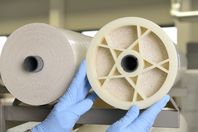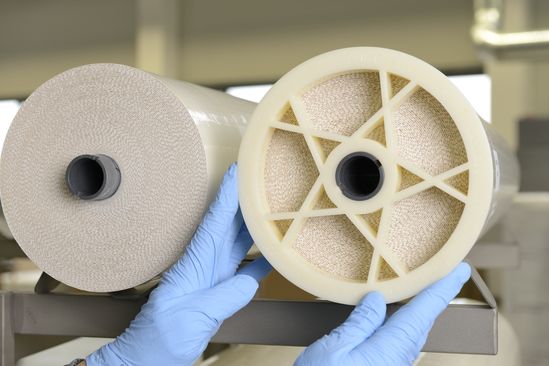Asia
EMEA

LANXESS Canada Contacts
Contact our Sites in Canada
Media Inquiries
General Inquiries
Please click here to e-mail LANXESS Canada with product inquiries and general requests.
Global Press Releases
2017-07-04
LANXESS expands range of membranes for reverse osmosis
- Three new Lewabrane products for treating drinking water and wastewater
- Removal of trace elements in end-of-pipe solutions
- Pilot plant incorporating Lewabrane elements, part of the “Multi-ReUse” project funded by the BMBF, goes into operation in July 2017
Specialty chemicals company LANXESS is expanding its range of membrane elements for reverse osmosis (RO). The new Lewabrane RO ULP line has three product grades available immediately for water treatment. They display higher water permeability than the standard elements, while offering the similar high level of rejection of critical substances. The operating pressure required in the pressure vessel is 40 percent lower, which reduces operating costs. Furthermore, the new membranes are a good option for removing trace elements from wastewater and drinking water.
“The new ULP products are recommended for applications in which a high flow rate, moderate salt rejection and low power consumption are the primary design parameters. Fields of application therefore are the cost-efficient filtration of drinking water and high-tech wastewater treatment,” says Alexander Scheffler, director membrane business in the LANXESS Liquid Purification Technologies business unit (LPT). “Our customers are so impressed with the performance profile that we already have received numerous pre-orders,” he adds.
Eliminating trace elements cost-efficiently at low operating pressures
Synthetic organic substances, known as trace elements, can be found in bodies of water in concentrations of a few nanograms to a maximum of a few micrograms per liter. Originating for instance from drugs, household chemicals, industrial chemicals, cosmetic products and crop protection agents, they are introduced into the water system by household and industrial wastewater.
The product designation “ULP” stands for “Ultra Low Pressure,” because the advantage of these membranes is their ability to remove such organic compounds almost entirely even at low operating pressures. “Drinking water systems process tremendous volumes of surface water often on a daily basis. Therefore, to minimize investment costs, it is desirable to have a membrane that displays high water permeability and thus a high flow rate, like those in our Lewabrane RO ULP line,” explains Scheffler.
To reduce the formation of organic deposits – i.e. typical biofouling – in wastewater, the ULP membrane uniquely has the most hydrophilic surface of all the Lewabrane product grades. Thanks to this hydrophilic behavior, a thin, protective film of water forms on the membrane surface, which reduces the adsorption of organic substances.
The ASD feed spacers, which are inserted in the membrane elements to create space between their surfaces for flowing water, also reduce fouling. They have an alternating strand design (ASD), comprising filaments of different thickness, which cause uniform overflow and thus counteract biofouling. This lowers operating costs because fewer cleaning chemicals are required and the interval between cleanings can be extended.
Multi-ReUse Project: Lewabrane in end-of-pipe solutions
The research project on “Modular Treatment and Monitoring in Wastewater Recycling (Multi-ReUse)” was launched in 2016 with funding from the German Federal Ministry of Education and Research (BMBF). This project aims to develop and improve processes for the economical use of wastewater. Against this backdrop, the Oldenburgisch-Ostfriesische Wasserverband (OOWV Water Management Association) joined forces with research partners – IWW Zentrum Wasser GmbH and the Biofilm Center at Duisburg-Essen University (UDE) – and equipment companies – inge GmbH, IAB Ionenaustauscher GmbH Bitterfeld (a wholly owned LANXESS subsidiary) and De.EnCon GmbH – to develop flexible processes for producing defined water qualities and volumes. To achieve its goals, the consortium is using innovative processing combinations and new developments in the field of membrane technology. At the same time, fast and reliable methods are being developed for process control and for monitoring the quality of hygiene-relevant parameters.
The results are being implemented at the Nordenham water treatment plant in Lower Saxony in collaboration with the OOWV. This pilot facility is due to go into operation in July 2017. It incorporates membrane elements from LANXESS, including the new ULP products. “We are studying the fouling and rejection behavior of our membrane elements in long-term practical trials,” explains Scheffler.
For detailed information on LANXESS’s new membranes and its extensive range of water treatment products, go to http://lpt.lanxess.com.
Forward-Looking Statements
This company release contains certain forward-looking statements, including assumptions, opinions, expectations and views of the company or cited from third party sources. Various known and unknown risks, uncertainties and other factors could cause the actual results, financial position, development or performance of LANXESS AG to differ materially from the estimations expressed or implied herein. LANXESS AG does not guarantee that the assumptions underlying such forward-looking statements are free from errors nor does it accept any responsibility for the future accuracy of the opinions expressed in this presentation or the actual occurrence of the forecast developments. No representation or warranty (expressed or implied) is made as to, and no reliance should be placed on, any information, estimates, targets and opinions, contained herein, and no liability whatsoever is accepted as to any errors, omissions or misstatements contained herein, and accordingly, no representative of LANXESS AG or any of its affiliated companies or any of such person's officers, directors or employees accept any liability whatsoever arising directly or indirectly from the use of this document.
LANXESS is a leading specialty chemicals company with sales of EUR 7.7 billion in 2016 and about 19,200 employees in 25 countries. The company is currently represented at 75 production sites worldwide. The core business of LANXESS is the development, manufacturing and marketing of chemical intermediates, additives, specialty chemicals and plastics. Through ARLANXEO, the joint venture with Saudi Aramco, LANXESS is also a leading supplier of synthetic rubber. LANXESS is listed in the leading sustainability indices Dow Jones Sustainability Index (DJSI World) and FTSE4Good.
- Gallery






